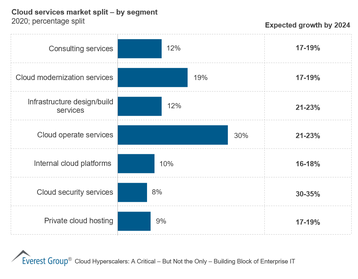Hyperscale providers have been growing very fast, partly because enterprises have been moving their IT into the public cloud, but non-hyperscale providers are still able to offer something distinctive, according to an Everest Group report.
Amazon Web Services (AWS), Google Cloud, and Microsoft Azure will grab more enterprise IT spend, with compound growth rates of 24 percent, according to the report. But these customers also want to avoid getting locked into any one provider and want to try unique pricing models that the smaller players can offer - if only because their own private clouds and traditional infrastructure remain important to them.
Private cloud remains important
"More than 90 percent of enterprises already leverage one or more public clouds in their enterprise environment," says the report adding: "Covid-19 has further accelerated enterprise migration to the public cloud, with most enterprises reaping business continuity benefits during the pandemic.
While hyperscalers now plan to dominate enterprise IT spend, they may have to diversify into more specific offerings beyond the full-stack cloud, to services like AI and machine learning, the report says. They are also evolving from their traditional monolithic offerings to provide financial and technical support, as well as enterprise training.
Despite this, non-hyperscalers still have cards they can play, as enterprises continue to use private cloud, multi-cloud and traditional infrastructure.
According to Everest, the smaller fish can offer more tailored pricing, including on-premise deployment. They've learned from the hyperscalers that "as-a-service" options are popular, and are offering "local cloud" to persuade more reluctant enterprises to adopt a version of the cloud.
Everest also suggests that some of these providers actually build products that customers want: "Infrastructure vendors are bringing in innovative service offerings, not to compete with cloud hyperscalers but to demonstrate their capabilities to help clients in building a digital business."
Some of these innovations fill in the gaps left by the big players' approach: enterprise-grade security, workload-specific compute, single pane of management, and transparent invoicing.
They also provide the consulting grunt-work to get new IT systems running: "IT service providers have developed this skill set, whereas hyperscalers, comparatively, have a lesser understanding of the enterprise IT landscape."

